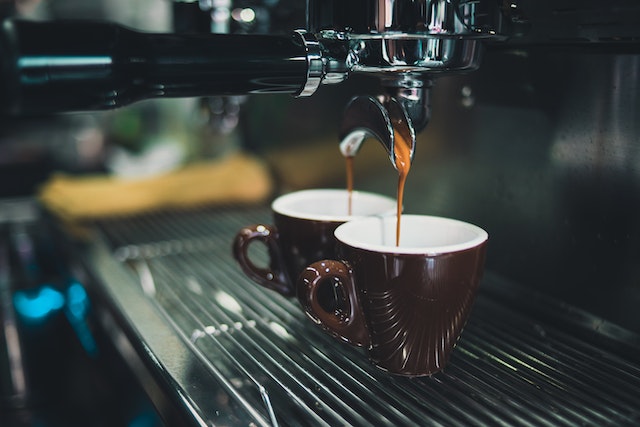
How is decaffeinated coffee made? There are several different methods, but they all involve washing the caffeine out of the coffee beans.
Coffee grows on a bush, which is usually about 1.5 m high. The coffee bean is the seed of the bush and it grows inside a red cherry. The cherries are picked when they are red and the coffee beans are taken from them, dried, and roasted.
Coffee plants produce caffeine for two reasons. The first reason is to ward off pests. The caffeine is in the entire coffee plant, not just in the beans, and it is toxic to most insects. It can shut down the nervous system of insects, paralyzing them and preventing them from breathing. This obviously makes pests avoid the plant. However, there is a beetle called the coffee berry borer beetle that is immune to caffeine. They have a bacteria in their gut that metabolizes the caffeine and lets the beetle eat the coffee berries without harm. These beetles live on coffee plants and have become the largest coffee plant pest in nature.
The second reason plants produce caffeine is to attract pollinators. Honey bees actually become addicted to caffeine in the same way that we do. The flowers of coffee plants have just enough caffeine in them to activate the reward center in the bee, but not enough to be dangerous. The caffeine helps the bee remember where the flower is and they will lead more bees to the coffee plant.
There are many species of coffee plant, but most of the world’s coffee comes from two. These are Robusta and Arabica. Arabica coffee has a better taste and is more delicate. It also has less caffeine. The lower caffeine content means it is more at risk from pests, so it is grown at an altitude of between 500 m and 2,500 m to keep it clear of pests. Most of the bean coffee we buy is Arabica. Robusta doesn’t taste as good but it has a higher caffeine content. It is generally used for instant coffees or espresso coffees.
Caffeine affects us because it activates noradrenaline neurons and has an impact on the release of dopamine. This becomes addictive, but many people would rather have coffee without the caffeine. This has only been possible for the last one hundred or so years. In 1905, a German called Ludwig Roselius worked out how to take the caffeine out of coffee and patented his method. He started the company Kaffee HAG, which still exists, and it was the first company to sell decaffeinated coffee. Legend has it that he ordered some coffee beans and when they arrived they had been soaked in seawater during transit. He found that the seawater had taken almost all of the caffeine out of the beans.
Today, there are three different ways of making decaffeinated coffee and they all revolve around washing the caffeine out with something. The first way is by washing the caffeine out with chemicals. Ludwig Reselius found that seawater did the job, but it left the coffee a little salty. After a lot of experimentation, he discovered that benzene did a pretty good job of removing the caffeine and that is what he patented. Unfortunately, benzene is carcinogenic, so, today, the caffeine is washed out with ethyl acetate and methylene chloride. The green beans are steamed and then rinsed with the chemicals, which pulls out some of the caffeine. This is repeated 8 to 12 times until enough of the caffeine has gone. 97% needs to be removed for it to be classified as decaffeinated.
The second method is called the Swiss Water Process. Green coffee beans are soaked in water until the water becomes saturated with all the components of the coffee beans. The caffeine is then removed from this coffee bean soup using charcoal filters. Fresh coffee beans are then placed in the decaffeinated coffee soup and the caffeine is drawn out of the beans into the decaffeinated soup where it is removed with filters. This process leaves the beans undamaged.
The third method uses carbon dioxide. When carbon dioxide is pressurized and heated to its critical point, which is the point just after it stops being a gas and just before it becomes a liquid, it becomes a supercritical fluid, which has the properties of both a gas and a liquid. Coffee beans are steamed and then placed in a high-pressure vessel. The supercritical carbon dioxide is circulated around the vessel and the caffeine dissolves into it, but the flavor and everything else in the coffee bean stays. The beans are then washed with high pressure water. This method is gaining in popularity at the moment.
The caffeine that is removed from the coffee is sometimes sold to pharmaceutical companies or to drinks companies. And this is what I learned today.
https://www.mpg.de/8365156/coffee-decaffeination-processes
https://www.ncausa.org/Decaffeinated-Coffee
https://www.nescafe.com/gb/understanding-coffee/coffee-beans/
https://en.wikipedia.org/wiki/Coffee_bean
https://www.nescafe.com/mena/en-ae/understanding-coffee/what-decaf-coffee
https://www.livescience.com/65278-how-decaf-coffee-is-made.html
https://www.scienceofcooking.com/caffeine-in-coffee-beans.html
